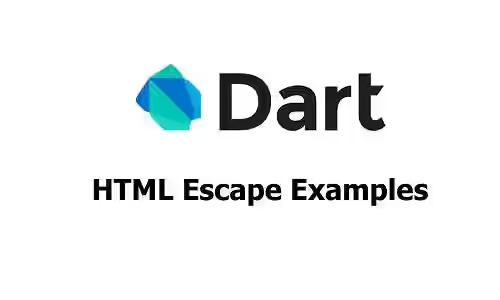
This tutorial gives you examples how to perform HTML encode in Dart, including how to set which characters will be escaped.
The class we're going to use is HtmlEscape, which is available in import 'dart:convert' library.
import 'dart:convert' show HtmlEscape, HtmlEscapeMode;
void main() {
String unsafeHtml = 'Welcome to <a href="https://www.woolha.com">woolha.com</a>. The \'cutest\' programming blog ever.';
HtmlEscape htmlEscape = const HtmlEscape();
print(htmlEscape.convert(unsafeHtml));
}The output is:
Welcome to <a href="https://www.woolha.com">woolha.com</a>. The 'cutest' programming blog ever.By default, Dart will escape < & >, " (double quote), ' (apostrophe), and / (slash). However, you can choose what you want to escape by passing an optional parameter to the HtmlEscape whose type is HtmlEscapeMode. Below are list of modes provided by Dart along with what characters are escaped by each mode.
| Mode | < & > |
" (double quote) |
' (apostrophe) |
/ (slash) |
|---|---|---|---|---|
unknown (default) |
✔ | ✔ | ✔ | ✔ |
attribute (default) |
✔ | ✔ | ✘ | ✘ |
sqAttribute (default) |
✔ | ✘ | ✔ | ✘ |
element (default) |
✔ | ✘ | ✘ | ✘ |
HtmlEscape htmlEscape = const HtmlEscape(HtmlEscapeMode.element);The output is:
Welcome to <a href="https://www.woolha.com">woolha.com</a>. The 'cutest' programming blog ever.If you need custom mode, for example you want to escape only double quote, you can create a new HtmlEscapeMode.
const HtmlEscapeMode customMode = const HtmlEscapeMode(name: 'doubleQuoteOnly', escapeQuot: true);
HtmlEscape htmlEscape = const HtmlEscape(customMode);The output is:
Welcome to <a href="https://www.woolha.com">woolha.com</a>. The 'cutest' programming blog ever.Please note that, if you call element.setInnerHtml, Dart will automatically sanitize unsafe string. Therefore, you don't need to manually escape the HTML.
